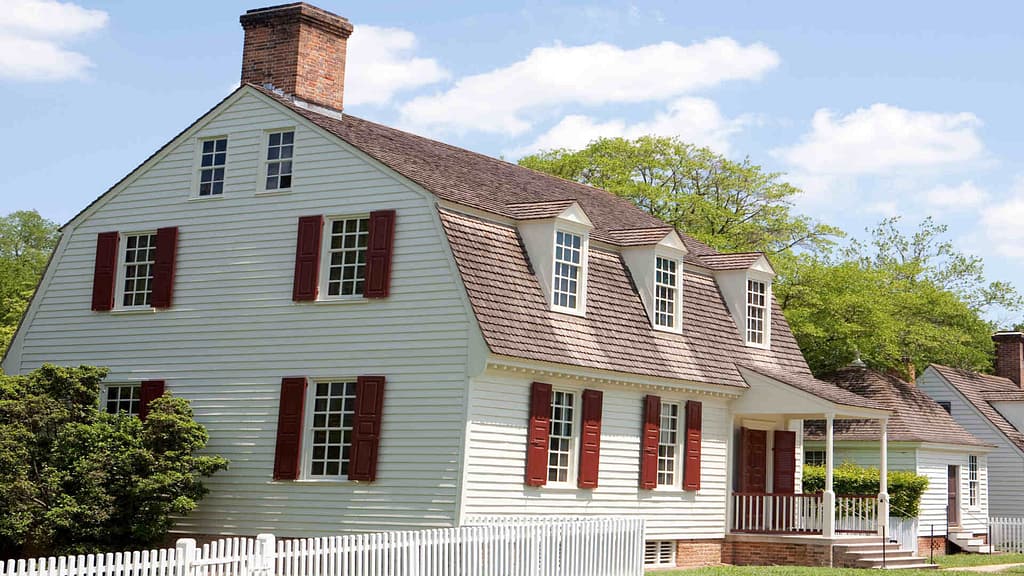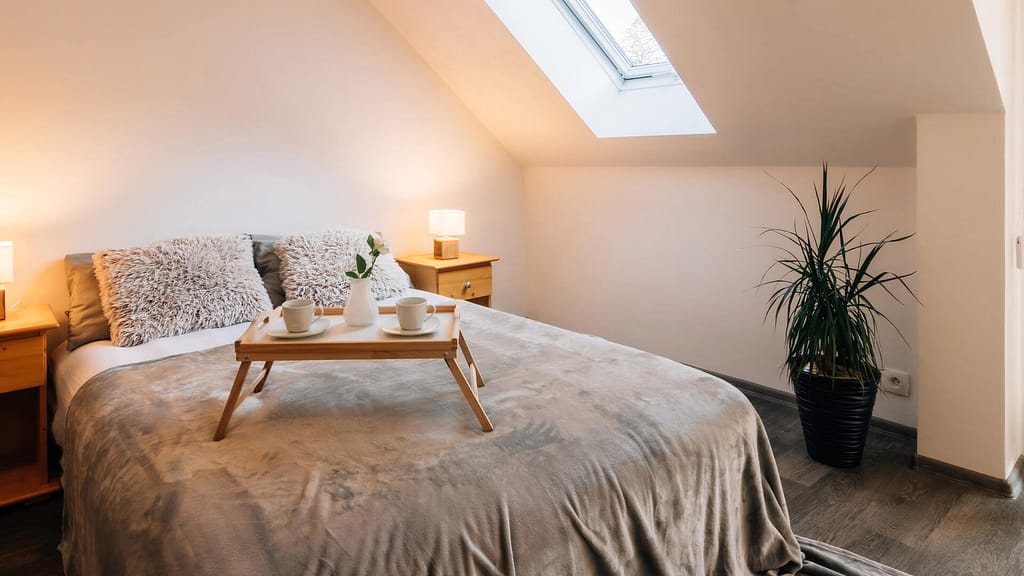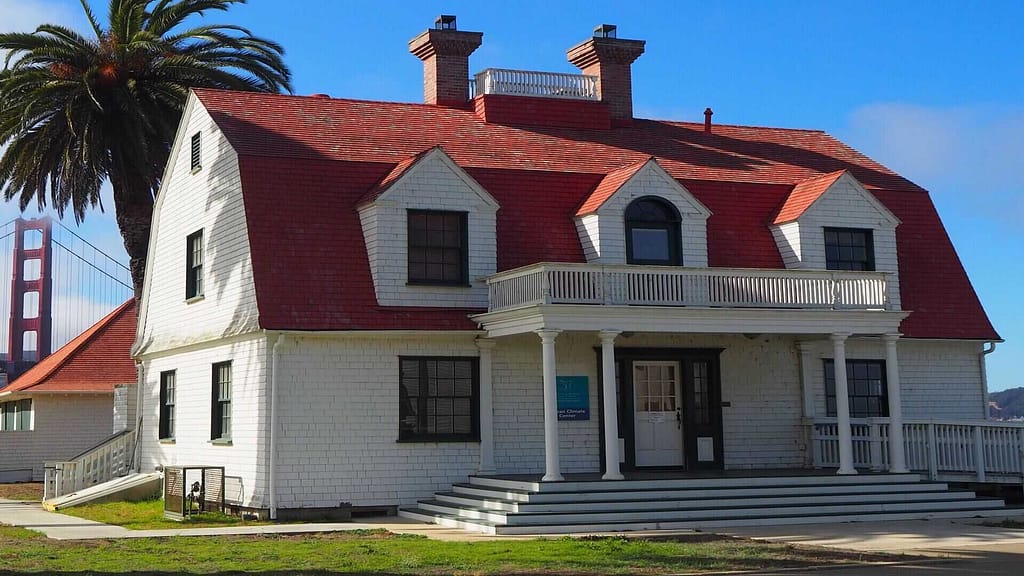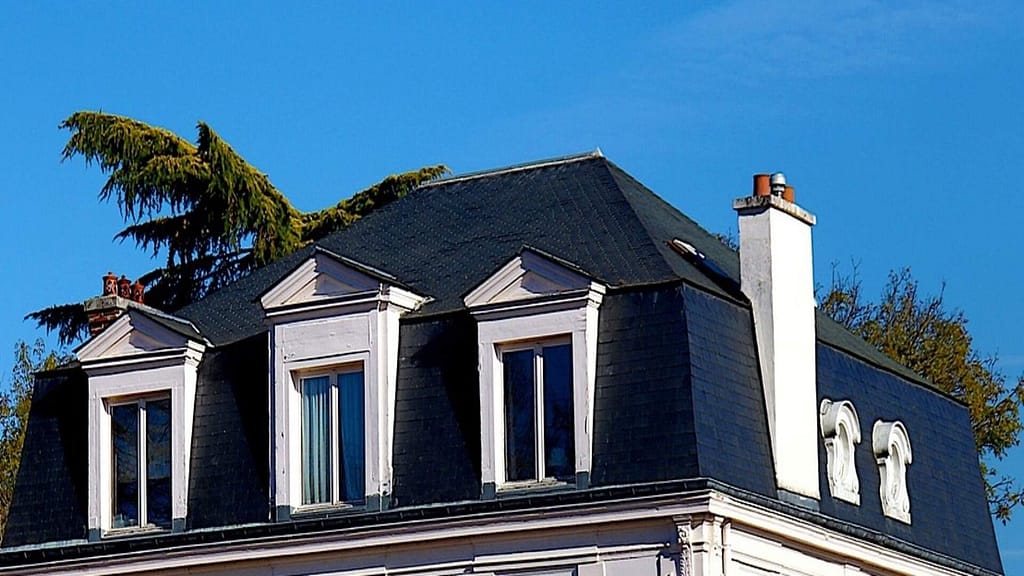A mansard roof is a four-sided roof style with two slopes on each side, the lower slope being steeper than the upper. Originating in Europe, this design allows for increased living space under the roof and often has small windows.
Table of contents
A Brief History of the Mansard Roof
The mansard roof features two distinct slopes on each side. It began in the mid-16th century, as noted by Britannica. It was used in England, Italy, and even in the Louvre by architect Pierre Lescot. The name comes from François Mansart, a French architect who made it famous in Paris.
This type of roof became famous because it matched well with other building styles of that time. Also, adding little windows gave more room inside. In the 1800s, this design was popular in France and the U.S. The mansard roof fit nicely with the popular designs back then.
Mansard Roof in Contemporary American Homes

The mansard roof comes from France and is now popular again in modern American houses. This roof uses materials like metal and solar panels. This roof uses materials like metal and solar panels. It’s ideal for city houses as it conserves space. If you’re interested, consult a local roofer.
Basic Structure and Design
The mansard roof has two main parts. The top part has a less steep pitch, and typically you can’t see it from the ground. It helps rainwater slide off easily. Below that, there’s a steep part that looks almost like the side of a house, which provides more room under the roof.
Sometimes, this roof has windows that stick out, letting light in for the upper room. Before, these roofs in France often used slate as a material. But today, people use different things like shingles or metal. The roof slopes down on all sides, making it look the same from every angle.
Materials Used
Before, mansard roofs in France used slate. Now, they use different materials. Here are a few:
- Shingles: Many roofs use wood, asphalt, or a combination of materials. Cedar is a popular wood choice, while asphalt is affordable and has various styles.
- Metal: Using materials like copper, zinc, or steel for mansard roofs has grown in popularity due to their sleek, modern appearance and durability. These materials not only promote efficient rainwater runoff with their smooth surfaces.
- Solar Roof: Most recently we saw a mansard roof project with Tesla Solar Roof. They claim it’s the world’s steepest solar roof and we believe them. See the project for yourself.
Advantages of the Mansard Roof in the American Setting
In America, mansard roofs are popular because they look stylish and offer practical benefits. They add a European touch, making homes unique. These roofs also provide extra room inside, a big plus in crowded cities.
On top of that, they can increase a home’s value. So, for American homeowners, choosing a mansard roof means getting a mix of elegance and space-saving design.
Maximizing Urban Space

In both busy cities and the quiet countryside, space is valuable. The mansard roof stands out as a versatile design solution. This roof design increases indoor space without using more land and needs less change than other styles. People like this roof because it looks good and saves space effectively.
Aesthetic Appeal
The mansard roof gives American homes a special touch. It has a different shape that stands out and adds style. This shape has hints of both European and American designs. Because of its versatile look, this roof can fit many different types of homes.
This feature not only enhances the appearance of homes but also adds extra interior space, providing both style and functionality for homeowners.
Versatility for Renovations
The mansard roof stands out for its adaptability, especially regarding renovations. With its steep sides, homeowners can easily add windows or incorporate new rooms, a feature not often found in other roof designs.
As your family grows or needs change, the mansard roof can evolve with you, allowing for seamless expansions or modifications. Its design brings aesthetic appeal and practical benefits, making it a favored choice for those who anticipate future home adjustments.
Considerations for a Mansard Roof

When Americans consider the mansard roof for their homes, there are unique factors to ponder. While its European design adds flair, the cost can be higher due to its intricate structure. Places with heavy snow pose challenges for its nearly flat top.
Maintenance differs from typical American roofs. In U.S. neighborhoods, a mansard roof can be a standout feature, blending old-world charm in a modern American context.
Cost Implications
Choosing a mansard roof might cost more due to specialized materials and expert craftsmanship. The extra space it provides can also add to the price. It’s wise to check local costs and weigh the benefits before deciding on this roof style.
Navigating HOA Regulations
If you’re considering a mansard roof, it’s essential to consult your HOA guidelines. Some associations have strict standards regarding house appearances.
Before deciding, check the HOA rules and contact them for clarity. They can inform you if a mansard roof is allowed or if there are particular requirements to follow.
Weather Considerations

Mansard roofs have a unique style, but before you decide, it’s good to think about the weather in your area. These roofs react differently to snow, wind, rain, and sun. Knowing how they perform in various conditions will help you make an informed choice for your home.
Hurricane-Prone Areas
In hurricane-prone areas like Florida, mansard roofs can help resist strong winds. However, roofs can get damaged if they aren’t strong enough, potentially leading to a costly roofing replacement in Florida or similar hurricane-prone regions.
Rainy Regions
For areas that get much rain, it’s vital to have good drainage on mansard roofs. The flat top should let water run off and not collect. A well-made roof stops water from pooling and causing damage. Proper gutters also help direct rainwater away from the house.
Sunny and Hot Areas
In sunny regions, the mansard roof’s sloping design can absorb more sunlight, potentially heating the home’s interior. To counter this, homeowners often use sun-reflective materials. These materials help maintain a cooler indoor environment and contribute to reduced cooling expenses.
Snowy Northern States
In snowy areas, the flat top of a mansard roof can gather a lot of snow, adding extra weight. The roof needs to be strong. Also, melting and refreezing snow can create ice dams, which might cause leaks. To avoid this, ensure the roof is well-built and has good insulation to prevent ice dams.
Conclusion
The mansard roof has been around for a long time, starting in Europe and now existing in many American homes. It’s popular because it looks good and gives extra room in the house. But before choosing this roof, homeowners should consider the cost and how it will handle different weather conditions.
Ultimately, this roof style is ideal for those seeking elegance and function. Before deciding, it’s wise to consult with a local roofing specialist to ensure it suits your home perfectly.
Fact checked by Christinne Somo – 10/23/23
